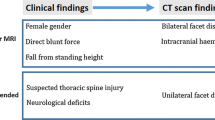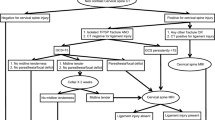Abstract
Objectives
Blunt cervical vascular injuries (BCVI) from alpine sports accidents bear an increased risk for being underdiagnosed during initial radiological evaluation. At our hospital, the “Innsbruck Emergency Algorithm”, which includes assessment of the neck as a computed tomography (CT) angiography during initial whole-body CT, has been introduced to avoid misdiagnoses and optimizes emergency radiology management.
Methods
Critically injured patients who were admitted for emergency CT after trauma from alpine skiing and mountain-biking accidents and who were reported with BCVI were included in this retrospective study.
Results
During 2003–2009, 36 victims were eligible for inclusion. They presented with a mean (SD) of 4.6 (2.1) diagnoses per patient, of which 3.5 (2.3) were perceptible on radiology examinations only. The “Innsbruck Emergency Algorithm” was performed in 15 individuals while 21 underwent another CT protocol including a native scan of the neck or during a parenchymatous contrast-medium phase only. In addition to BCVI, most patients (71%) were diagnosed with fractures followed by unspecific contusion/s (54%), head injuries (43%), and injuries of parenchymatous organs (19%). In five (14%), BCVI was underdiagnosed during the initial radiological examination. All of the latter had CT during a parenchymatous contrast-medium phase and not according to the “Innsbruck Emergency Algorithm”. Four of those patients died during their hospital stay. In 11, cerebral follow-up examinations showed cerebral pathologies considered as results from BCVI.
Conclusions
The “Innsbruck Emergency Algorithm” in patients with clinically unapparent BCVI after skiing and mountain-biking accidents avoided overlooking vascular injuries, which significantly improved their long-term outcome.



Similar content being viewed by others
References
Berne JD, Norwood SH, McAuley CE, Vallina VL, Creath RG, McLarty J (2001) The high morbidity of blunt cerebrovascular injury in an unscreened population: more evidence of the need for mandatory screening protocols. J Am Coll Surg 192(3):314–321
Biffl WL, Moore EE (1999) Identifying the asymptomatic patient with blunt carotid arterial injury. J Trauma 47(6):1163–1164
Biffl WL, Moore EE, Elliott JP, Ray C, Offner PJ, Franciose RJ, Brega KE, Burch JM (2000) The devastating potential of blunt vertebral arterial injuries. Ann Surg 231(5):672–681
Fabian TC, Patton JH Jr, Croce MA, Minard G, Kudsk KA, Pritchard FE (1996) Blunt carotid injury. Importance of early diagnosis and anticoagulant therapy. Ann Surg 223(5):513–525
Sclafani SJ, Cavaliere G, Atweh N, Duncan AO, Scalea T (1991) The role of angiography in penetrating neck trauma. J Trauma 31(4):557–563
Biffl WL, Egglin T, Benedetto B, Gibbs F, Cioffi WG (2006) Sixteen-slice computed tomographic angiography is a reliable noninvasive screening test for clinically significant blunt cerebrovascular injuries. J Trauma 60(4):745–752
Biffl WL, Moore EE, Offner PJ, Brega KE, Franciose RJ, Elliott JP, Burch JM (1999) Optimizing screening for blunt cerebrovascular injuries. Am J Surg 178(6):517–522
Biffl WL, Ray CE Jr, Moore EE, Mestek M, Johnson JL, Burch JM (2002) Noninvasive diagnosis of blunt cerebrovascular injuries: a preliminary report. J Trauma 53(5):850–856
Rieger M, Sparr H, Esterhammer R, Fink C, Bale R, Czermak B, Jaschke W (2002) Modern CT diagnosis of acute thoracic and abdominal trauma. Radiologe 42(7):556–563
Baker SP, O’Neill B, Haddon W Jr, Long WB (1974) The injury severity score: a method for describing patients with multiple injuries and evaluating emergency care. J Trauma 14(3):187–196
Parent AD, Harkey HL, Touchstone DA, Smith EE, Smith RR (1992) Lateral cervical spine dislocation and vertebral artery injury. Neurosurgery 31(3):501–509
Willis BK, Greiner F, Orrison WW, Benzel EC (1994) The incidence of vertebral artery injury after midcervical spine fracture or subluxation. Neurosurgery 34(3):435–442
Cothren CC, Moore EE, Biffl WL, Ciesla DJ, Ray CE Jr, Johnson JL, Moore JB, Burch JM (2003) Cervical spine fracture patterns predictive of blunt vertebral artery injury. J Trauma 55(5):811–813
Maron BJ, Poliac LC, Ashare AB, Hall WA (2003) Sudden death due to neck blows among amateur hockey players. JAMA 290(5):599–601
Miller PR, Fabian TC, Croce MA, Cagiannos C, Williams JS, Vang M, Qaisi WG, Felker RE, Timmons SD (2002) Prospective screening for blunt cerebrovascular injuries: analysis of diagnostic modalities and outcomes. Ann Surg 236(3):386–395
Rodriguez M, Tyberghien A, Matge G (2001) Asymptomatic vertebral artery injury after acute cervical spine trauma. Acta Neurochir (Wien) 143(9):939–945
Miller PR, Fabian TC, Bee TK, Timmons S, Chamsuddin A, Finkle R, Croce MA (2001) Blunt cerebrovascular injuries: diagnosis and treatment. J Trauma 51(2):279–286
Kerwin AJ, Bynoe RP, Murray J, Hudson ER, Close TP, Gifford RR, Carson KW, Smith LP, Bell RM (2001) Liberalized screening for blunt carotid and vertebral artery injuries is justified. J Trauma 51(2):308–314
Pelkonen O, Tikkakoski T, Leinonen S, Pyhtinen J, Lepojarvi M, Sotaniemi K (2003) Extracranial internal carotid and vertebral artery dissections: angiographic spectrum, course and prognosis. Neuroradiology 45(2):71–77
Huber-Wagner S, Lefering R, Qvick LM, Korner M, Kay MV, Pfeifer KJ, Reiser M, Mutschler W, Kanz KG (2009) Effect of whole-body CT during trauma resuscitation on survival: a retrospective, multicentre study. Lancet 373(9673):1455–1461
Rieger M, Czermak B, El Attal R, Sumann G, Jaschke W, Freund M (2009) Initial clinical experience with a 64-MDCT whole-body scanner in an emergency department: better time management and diagnostic quality? J Trauma 66(3):648–657
Conflict of interest statement
None of the authors has any financial or non-financial competing interests to declare.
Author information
Authors and Affiliations
Corresponding author
Rights and permissions
About this article
Cite this article
Wick, M.C., Weiss, R.J., Lill, M. et al. The “Innsbruck Emergency Algorithm” avoids the underdiagnosis of blunt cervical vascular injuries. Arch Orthop Trauma Surg 130, 1269–1274 (2010). https://doi.org/10.1007/s00402-010-1068-5
Received:
Published:
Issue Date:
DOI: https://doi.org/10.1007/s00402-010-1068-5




